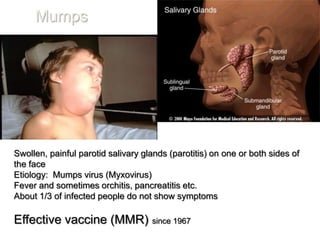Chapter23 digestivepart1marieb
- 1. Digestive System, Part 1 Objectives: Discuss the general functions and anatomy of the digestive tract, including accessory structures. First, an overview of the tubular nature of the digestive system. Describe the individual organs of the system, including a discussion of the gross and microscopic anatomy. Developed by John Gallagher, MS, DVM
- 2. Digestive System Overview AKA: Digestive Tract Alimentary Tract or Canal GI tract Gut Muscular, hollow tube, from the lips to the anus + Various accessory organs
- 3. Digestive System Overview The function of the system as a whole is processing food in such a way that nutrients can be absorbed and residues eliminated. Individual parts function in: • Ingestion • Propulsion • Mechanical digestion and segmentation • Chemical and enzymatic digestion • Secretion • Absorption • Compaction • Excretion and elimination (defecation)
- 4. Membranes Peritoneum - generic serous membrane in abdominal cavity Parietal and Visceral Peritoneum Retroperitoneal vs. (intra)peritoneal Mesenteries - double sheets of peritoneum, surrounding and suspending portions of the digestive organs • Greater omentum - "fatty apron", hangs anteriorly from Fig. 22.6 stomach; double layer encloses fat • Lesser omentum - between stomach and liver • Mesentery proper - suspends and wraps the small intestine • Mesocolon - suspends and wraps the colon, parts are – transverse mesocolon – sigmoid mesocolon
- 6. Structure of Small Intestinal Wall Plicae circulares – circular pleats around the interior of the small intestine Villi – minute finger-like projections, contain capillaries & lacteals Microvilli – sub-microscopic size, projections on single cells Function of all three? Crypts at bottom of villi—Cell regeneration (mitosis) Glands—mucus, enzymes
- 7. Smooth Muscle, a review • One nucleus • Nonstriated – Actin and myosin present • Slow, sustained contraction • Communication – Varicosities – Gap junctions
- 8. Histological Organization Tube made up of four layers. 1. Mucosa 2. Submucosa 3. Muscularis externa 4. Serosa = Visceral Peritoneum Modifications along its length as needed.
- 9. The 4 Layers of the Gut 1) Mucosa Epithelium - usually simple columnar epithelium with goblet cells; may be stratified squamous if protection needed, e.g., esophagus Lamina propria – areolar connective tissue deep to epithelium Muscularis mucosae -produces folds - plicae (small intestine) or Fig 23.7 rugae (stomach)
- 10. The 4 Layers of the Gut 2) Submucosa – made up of loose connective tissue contains submucosal plexus and blood vessels Fig 23.7
- 11. The 4 Layers of the Gut 3) Muscularis externa – smooth muscle, usually two layers (controlled by the myenteric plexus; source of peristalsis ) - inner layer: circular outer layer: longitudinal Fig 23.7
- 12. The 4 Layers of the Gut 4) Serosa visceral layer of mesentery (contiguous with the peritoneum) or adventitia depending on location Fig 23.7
- 14. Oral Cavity • AKA buccal cavity or mouth - lined with oral mucosa (type of epithelium ?) • Lips = labia – Labial frenulum • Hard and soft palates - form roof of mouth • Tongue - skeletal muscle – Lingual frenulum • Salivary glands - three pairs • Teeth • Fauces = opening to pharynx
- 15. Types and Numbers of Teeth Dental succession Deciduous (1o, baby, milk) teeth - 20, replaced by Permanent teeth - 32 teeth
- 16. Structure of Teeth Fig 23.14 Crown - exposed surface of tooth Neck - boundary between root and crown Enamel - outer surface Dentin – bone-like, but noncellular Pulp cavity - hollow with blood vessels and nerves Root canal - canal length of root Gingival sulcus - where gum and tooth meet Periodontal Ligament
- 17. Three pairs of Salivary Glands 1-1.5 L / day for digestion (?) lubrication (swallowing) moistening (tasting) • Parotid – lateral side of face, anterior to ear, drain by parotid duct to vestibule near 2nd upper molar • Submandibular – medial surface of mandible – drain near lingual frenulum drain posterior to lower molars • Sublingual – in floor of mouth - drain near lingual frenulum
- 18. Mumps Swollen, painful parotid salivary glands (parotitis) on one or both sides of the face Etiology: Mumps virus (Myxovirus) Fever and sometimes orchitis, pancreatitis etc. About 1/3 of infected people do not show symptoms Effective vaccine (MMR) since 1967
- 19. Esophagus • Lined with noncornified stratified squamous epithelium • Food boluses propelled by peristalsis of both skeletal and smooth muscle (gravity, too) • Hiatus; lower esophageal sphincter • GERD
- 20. Stomach oCardiac Sphincter (?) oCardia oFundus oBody oPylorus oPyloric sphincter oGreaterand Lesser Curvatures oGreater Omentum
- 21. Stomach •Rugae or Rugal Folds •Pylorus •Pyloric sphincter
- 22. Circulation
- 23. Histology of Stomach Type of epithelium lining stomach? Gastric pits – shallow pits, external half rapidly reproduces for replacement Gastric glands – deep in lamina propria, 3 types of cells 1. Parietal cells (produce HCl and intrinsic factor B12) 2. Chief cells (produce pepsinogen) 3. Enteroendocrine cells – G cells (several hormones including gastrin which stimulates both parietal and chief cells)
- 24. Ulcers • Mucosal erosion of stomach or duodenum • GERD • NSAIDs • Helicobacter pylori • Stress?? • Dx by esophagogastroduodenoscopy http://www.you tube.com/watc h?v=hm1nEP HxJ0E
- 25. Review:

























